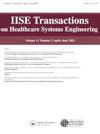Transient queueing analysis for emergency hospital management
IF 1.5
Q3 HEALTH CARE SCIENCES & SERVICES
IISE Transactions on Healthcare Systems Engineering
Pub Date : 2021-05-24
DOI:10.1080/24725579.2021.1933655
引用次数: 3
Abstract
Abstract Strategic and tactical capacity planning are critical decisions faced by hospitals. While these problems have received significant attention, current queueing-based approaches do not address realistic healthcare constraints such as blocking, transient arrivals, transient capacity assignments, and surge capacities. A queueing methodology is developed to extend the analysis of these constructs. The methodology developed is generic for hospitals responding to demand surges during epidemics and pandemics such as the recent COVID-19, and in other application areas in manufacturing, supply chain management, and logistics. The medical staff and patient chairs in the emergency room, beds in the operating theater, ICU, and medical/surgical care units are used in patient treatment at a hospital. They can be considered as servers in a system, where capacity and operational policies affect performance measures such as patient throughput. The methodology develops the probabilities from which system performance measures can be estimated for a serial queueing network with blocking. Transient analysis is employed, due to the time varying nature of the patient arrival patterns. The methodology has the capability to analyze different interventions such as increasing and decreasing capacities, and ambulance diversion. In order to handle typical hospital sized problems that result in thousands of ordinary differential equations defining the system probabilities, a transient version of Kanban queueing network decomposition is developed along with procedures for dealing with the discontinuities that arise at capacity changes. Verification/validation is presented along with several scenarios that illustrate the potential application of this methodology in emergency hospital management.急诊医院管理的暂态排队分析
战略和战术能力规划是医院面临的关键决策。虽然这些问题受到了极大的关注,但目前基于排队的方法并不能解决现实的医疗保健限制,例如阻塞、临时到达、临时容量分配和激增容量。开发了一种排队方法来扩展对这些构造的分析。所开发的方法是通用的,适用于医院在流行病和最近的COVID-19等大流行病期间应对需求激增,以及在制造、供应链管理和物流等其他应用领域。急诊室的医务人员和病人的椅子、手术室的床、ICU和内科/外科护理单位用于医院的病人治疗。可以将它们视为系统中的服务器,其中容量和操作策略会影响诸如患者吞吐量之类的性能度量。该方法提出了对具有阻塞的串行排队网络进行系统性能评估的概率。由于患者到达模式的时变性质,采用了瞬态分析。该方法具有分析不同干预措施的能力,如增加和减少能力,以及救护车分流。为了处理典型的医院规模的问题,导致成千上万个定义系统概率的常微分方程,开发了看板排队网络分解的瞬态版本,并开发了处理容量变化时出现的不连续性的程序。验证/确认与几个场景一起提出,说明该方法在急诊医院管理中的潜在应用。
本文章由计算机程序翻译,如有差异,请以英文原文为准。
求助全文
约1分钟内获得全文
求助全文
来源期刊

IISE Transactions on Healthcare Systems Engineering
Social Sciences-Safety Research
CiteScore
3.10
自引率
0.00%
发文量
19
期刊介绍:
IISE Transactions on Healthcare Systems Engineering aims to foster the healthcare systems community by publishing high quality papers that have a strong methodological focus and direct applicability to healthcare systems. Published quarterly, the journal supports research that explores: · Healthcare Operations Management · Medical Decision Making · Socio-Technical Systems Analysis related to healthcare · Quality Engineering · Healthcare Informatics · Healthcare Policy We are looking forward to accepting submissions that document the development and use of industrial and systems engineering tools and techniques including: · Healthcare operations research · Healthcare statistics · Healthcare information systems · Healthcare work measurement · Human factors/ergonomics applied to healthcare systems Research that explores the integration of these tools and techniques with those from other engineering and medical disciplines are also featured. We encourage the submission of clinical notes, or practice notes, to show the impact of contributions that will be published. We also encourage authors to collect an impact statement from their clinical partners to show the impact of research in the clinical practices.
 求助内容:
求助内容: 应助结果提醒方式:
应助结果提醒方式:


